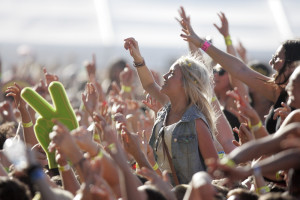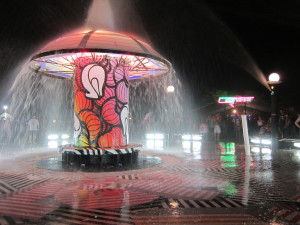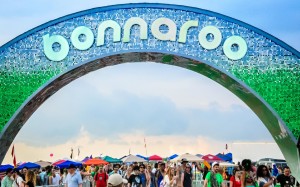The Digital Evolution of Music Festivals
Posted on Oct. 8, 2015, at 1:30 p.m.
by Hayley Kilgo.
It’s been 46 years since the famed Woodstock Music and Arts Festival, yet people are still gathering today to enjoy music with one another. However, it’s no surprise that music festivals have changed in the last several years with the increase of technology. Cigarette lighters have been replaced with cellphone lights and Polaroid pictures with Instagrams. Millennials are the key reason why the love of music festivals is coming back, along with technology and social media driving the resurgence.
“One of the most powerful aspects of a music festival is the large-scale, shared experience that it provides everyone in attendance,” said Neal Cohen, associate director of brand marketing, social and digital at Superfly, creators of Bonnaroo and OutsideLands music festivals.
The attendees want to share their experience with friends and the rest of the world. So how does a music festival keep up with the evolving social and digital trends?
 Brand identity
Brand identity
“One of the most important things a music festival can do is to know your audience and to listen to them. This is what allows good marketers to stand out from the rest,” said Megan Adams, communications director of Superfly.
Form a brand identity and invest in it. Adams said what differentiates Bonnaroo from other music festivals is the community that has grown from not only the voice of the festival, but also from realizing that no two experiences are alike. Establishing this reality early on allowed Bonnaroo to become something that is year-long rather than just a weekend.
The role of social media
Music festivals aren’t just music — there’s food, entertainment, lifestyle, comedy and more. It’s a total sensory experience. Social media extends the shelf life of the experience by sharing it with friends and inviting other people to be involved in it.
 Cohen said the role of social media for the music festival is to tell the story of the event’s meaning. However, social media also allows you to tell it in the way you want it to be told.
Cohen said the role of social media for the music festival is to tell the story of the event’s meaning. However, social media also allows you to tell it in the way you want it to be told.
Rebecca Gibson, in an article on Postano, aptly noted if you “attend any concert today, you’ll see attendees with their phones glued to their hands, posting selfies with the band, Instagram-ing the perfect festival outfit, and sending Snapchats of performances to friends back home.”
Gibson suggested that marketers should take advantage of the things that are already happening and create “a call to action to share posts on social displays within the production. Highlighting attendees by making them a part of the production creates an involved community, and puts the fans in the spotlight alongside the talent.”
Reach your target audience
According to AdAge, “millennials make up the largest segment of smartphone owners. In the second quarter of 2014, 85% of millennials ages 18–24 and 86% ages 25-34 owned devices. With the right audience targeting and geofencing capabilities, plus emerging technologies like beacons, it’s becoming easier than ever to reach your target audience at the right time and place on their mobile device.”
Today, most people are obsessed with consuming digitally, so music festivals have to adapt. Many festivals now offer wristbands with RFID technology, provide an app designed just for the music festival and, most importantly, have increased their social media presence.
Cohen said that Bonnaroo’s most successful social platform right now is Instagram, but the trends are constantly changing, so if any new apps emerge that their audience is using they would be there too.
Some of the future social media apps that are looking to be a big hit in music festivals would be ones that feature live channels, such as Snapchat, Meerkat and Periscope. Live channels are really powerful. They are only happening during that moment, but allow users who aren’t there to feel as if they are and to almost create a bit of FOMO. Snapchat has already proven to be extremely successful with this feature for music festivals, and Cohen said he is excited to see what new developments are to come.
 Work with sponsors
Work with sponsors
The AdAge article also noted that as for sponsors and branding at the music festival, “plastering your logo on a stage might be great for brand awareness, but if you truly want to make an impression, give festival-goers a real-life experience that makes them connect with your brand on a more tangible level.” For example, you should “create an experience that’s authentic to your brand and relevant to the festival’s spirit.”
“A lot of partners think their time to shine is during the four or five days of the event but really the most impressions happen during the lead up and even more so the week after the event when people recall what the experience was for them,“ Cohen said.
Cohen said that when partnering with brands at Bonnaroo, “you have to push them to trust that posting about their product on just social media isn’t going to give them their desired effect.”
Instead, if they are incorporated into the experience, it will pay off much more in the end, which is exactly what happened this year at Bonnaroo.
Overall, music festival marketers should keep up with the evolving social and digital trends. What used to be a stationary event is turning into a global phenomenon through the use of social platforms, and it is only going to continue to grow. So create a fan-first experience, listen to the attendees and form a strategic plan to keep ahead of the competition, because new festivals are forming every day.
Opinions
Comments are closed.





Post comment
I love how this article was broken down into four main sections of Brand Identity, The Role of Social Media, Reach of your Target Audience and Work with Sponsors. It really gets the reader thinking about how much chatter and posts each music festival generates. I also would be interested to find out if all of the same concepts apply to music festivals outside of the United States, such as European Ultra. Overall, it was a fantastic article.
PermalinkPost comment
Hayley, great post! I agree with a lot of your aspects and views on the increasing popularity of music festivals, as well as the reason behind it. With the fact that millennials are essentially the largest demographic as of 2015, it is essential that these music festivals target what millennials want. It is definitely the truth that music festivals now are not just about the music. After going to Lollapalooza in Chicago this past summer, I saw that fact firsthand. Social media has a way of extending these music festivals to way more people past the individuals that partake in the actual event. I also think it is imperative, for the survival of social media sites, to continue to cater to millennials as well as come up with new features that center around the idea of music festivals not just being about the music, but about the all around sensory experience that they offer.
PermalinkPost comment
Haley, I could not agree more. Around this time last year, I completed a research project based on the following hypothesis: “Those who utilize their electronic devices to access social media for an extensive amount of time while participating in an event may result in that individual enjoying their time less.” I have researched topics and ideas similar to your article, allowing me to easily understand and agree with your analysis. I feel Bonnaroo has a great view on utilizing social media efficiently. The festival’s stratgey is to use excessively use social media leading up to the event, but as the events are in progress, Bonnaroo’s social media accounts rarely post. The Bonnaroo staff does this to allow attendees to enjoy their time and to experience Bonnaroo without their electronic interruptions.
PermalinkPost comment
Great article, Hayley. I found this piece to be very relatable, especially with our generation and social media. I thought it was interesting and compelling how much thought was put into Bonnaroo’s social media strategies. Nowadays, in order for almost any company to be successful there must be a social media platform present to lure the audience in. Also, I enjoyed reading the concept about giving people who attend music festivals a real-life experience. I believe that is how you get the millennial generation to engage. We always want to know what is in it for us. By giving a real-life experience you are letting people feel like they are a part of the experience, and leaving them with an impact. It is all about capturing the target audiences’ engagement. The first step to achieving engagement is thinking what the audience wants, then giving that to them.
Permalink